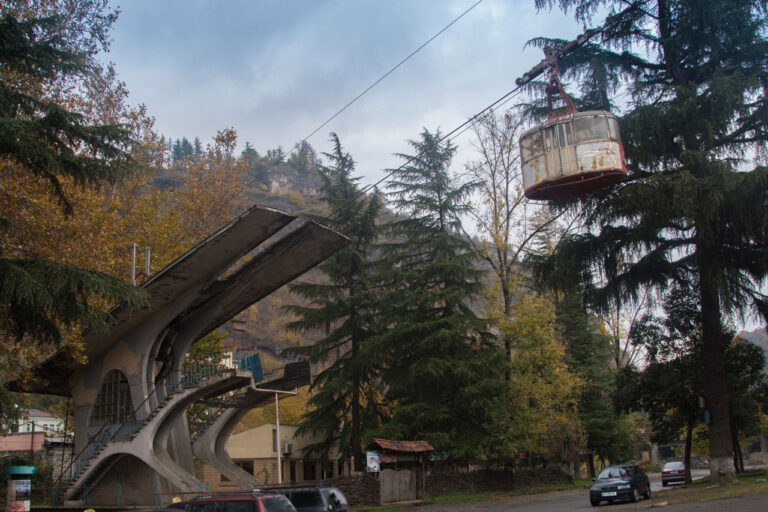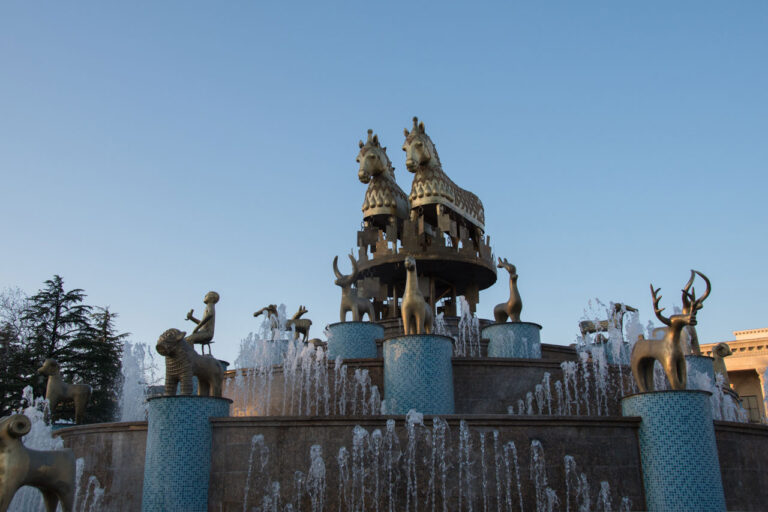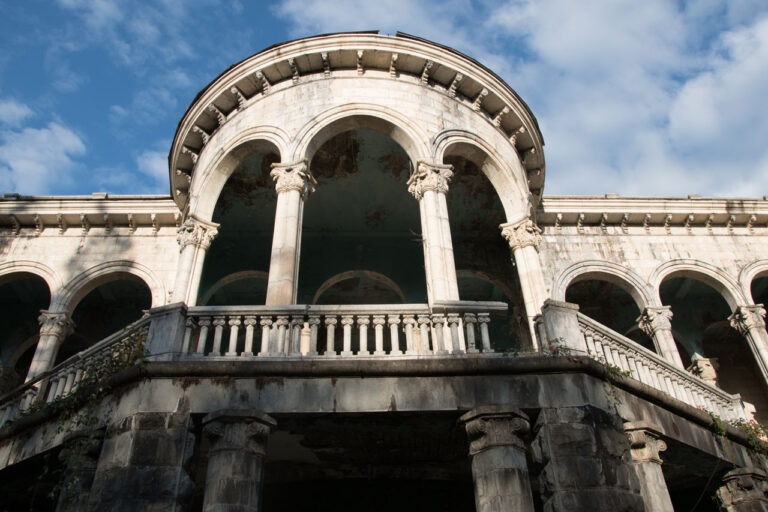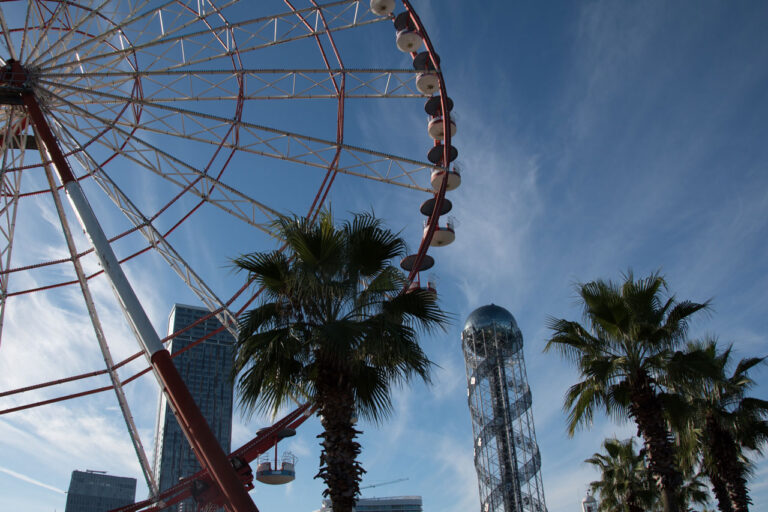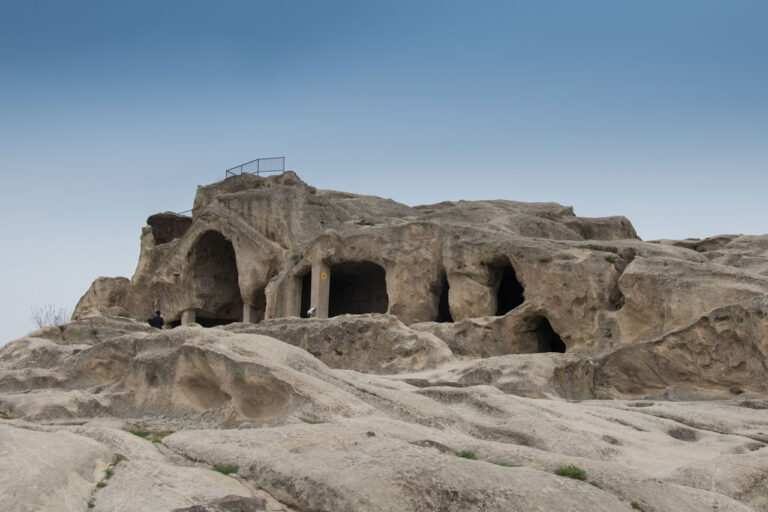This article may contain affiliate links.
Updated: August 24, 2025
Georgia was part of the USSR for a long 69 years, and that left a deep mark on the country. That era gave us loads of brutalist and modernist buildings, along with mosaics and bas-reliefs that are still standing today, stubbornly defying time.
But that’s not all—Russia’s influence goes back even further. Georgia became part of the Russian Empire in 1801, so the legacy runs deep.
In this article, I share the best spots to see Soviet architecture in Tbilisi, plus some amazing mosaics. At the end, I’ve included a few places that didn’t impress me much or have lost a lot of their charm, even though they show up on other lists.
Just a heads-up—while the first spot really is the most spectacular, the rest aren't in any particular order. I wrote them up in the order I visited, since this post is the result of almost a year of exploring. 😅
There’s not a lot of current info online about these sites or what condition they’re in. Some places I originally planned to include are already gone—either collapsed or demolished. So this post is also my way of documenting what’s still around, with a bit of my own personal rating.
How the rating works
I gave each place a score from 1 to 5, where:
- 1 means “don’t bother,”
- 5 is “an absolute must-see.”
I based the ratings on three things: how interesting the architecture is, how beautiful the place looks, and how well it’s been preserved. Of course, it’s all super subjective, but hopefully it’ll give you a good idea of what to expect.
And as always, there’s a map at the end of the post with all the locations pinned, so you can plan your own Soviet-style route through Tbilisi.
If you don’t have time to read the whole article, I recommend joining this Urbex and Soviet tour of Tbilisi. It’s super complete and entertaining.
Top Soviet Architecture Buildings in Tbilisi
1. Palace of Rituals
This is easily one of the most spectacular buildings in Tbilisi—and maybe in all of Georgia. If you’re into architecture (or even just curious about Soviet design), you can't miss it.
It was built specifically for weddings and is a prime example of Soviet modernism—a style that followed brutalism, with softer, more elegant lines that almost feel like something out of Le Corbusier’s playbook.

The coolest part? The two side sections are dedicated to each partner. On the bride’s side, there’s even a space for baptism ceremonies.
Even though it’s privately owned and not open to the public, the building is in amazing condition. The good news is that they’ve recently started offering guided tours for 100 lari (about €32).
For the best photos of the facade, try the road right in front or the nearby bridge.
👍 Fun fact: There’s a statue of Hermaphroditus (child of Aphrodite and Hermes) at the entrance. Since the building is all about the union of man and woman, they thought it was the perfect symbol.
- Rating: 5
- Year built: 1985
- Architect: Victor Jordenadze
- Can I go inside? Only with a guided tour
✅ Friendly Tip: Don’t forget to get travel insurance for your next adventure. I recommend Heymondo,—it’s super comprehensive, and with that link, you’ll get 5% off.
2. Chronicles of Georgia

This brutalist monument is as massive as it is unknown to most tourists, though it’s definitely appreciated by locals.
The Chronicles of Georgia tell the country’s story through carved reliefs on 16 towering columns—each one 30 to 35 meters tall. It’s absolutely huge, but what really makes it special is the location on a hill overlooking the “Tbilisi Sea” (which is actually a reservoir, but honestly, the view lives up to the name).
It was never fully finished, but it still has this monumental, solemn vibe that’s hard to beat.

- Rating: 4
- Year built: 1985
- Sculptor: Zurab Tsereteli
- Can I visit it? Yes
- Entrance Fee: Free
3. Stalin's Clandestine Underground Printing House
Okay... I’m kind of cheating with this one. 😅
It’s not exactly Soviet architecture, but I thought it deserved a spot on the list since it’s directly tied to Stalin and the early days of communism in Georgia.

The house is a typical Georgian home, very similar to Stalin’s birthplace in Gori. The interesting part is the basement, which used to be a secret printing press. From 1903 to 1906, revolutionary newspapers and pamphlets were printed and distributed right here. There are also rooms with personal items, letters, and tons of original publications from that time.

- Rating: 5
- Operating years: 1903 to 1906
- Can I visit it? Yes
- Entrance Fee: 10 lari (3.20 euros)
⭐ Related article: Visit to Gori and Uplistsikhe from Tbilisi
4. Isani Metro and its Mosaic
Isani station is a nice example of Soviet architecture. To me, it looks like a stingray flapping its fins. It’s modern, simple, and stylish.

There’s not much to see inside, except for a stunning mosaic of King Vakhtang on the upper floor.
Technically, photos inside the metro aren’t allowed. Snapping a quick one with your phone is usually fine, but be careful with big cameras—security might call you out.
- Rating: 5
- Year built: 1971
- Architect: N.Lomidze
- Can I go inside? Yes
5. Cable Car Station near Lisi Lake
Many of Tbilisi’s more modern transportation systems (well, modern for the time) were built during the Soviet era, and cable cars were no exception.

Near Lisi Lake, there’s this abandoned Soviet modernist cable car station that looks like it never even operated.
If you’re into urbex (exploring cool abandoned places), this could be a fun stop. There’s not much inside, but the exterior—especially the grand staircase—has a lot of character.
- Rating: 4
- Year built: 1978
- Architect: Gera Khechinashvili, Gia Nadiradze
👍 My two cents: If you’re looking to stay connected during your trip, 🤳 I recommend this eSIM for Georgia and with that link you get a 5% discount. If you're looking for a budget-friendly alternative this other eSIM starts at 4 euros.
6. Skybridge Building
The Skybridge is a group of three apartment blocks connected by a bridge on the 10th floor.
Sounds weird, I know, but it makes sense—the buildings are on a slope, and the bridge gives direct access to the street above.

It’s one of the most eye-catching examples of Soviet architecture in Tbilisi—and it even shows up in a Borjomi commercial (Georgia’s most famous mineral water).
You can spot it in the video below—right at the beginning, the main character is standing on the bridge.
The balconies are typical of the era, and you’ll see similar buildings all over the neighborhood.
👍 Fun fact: The facades look as if they were never finished. It’s all bare concrete, no decoration at all. Totally normal in Georgia, where functionality is often prioritized over aesthetics.

- Rating: 5
- Year built: between 1974 and 1976
- Architect: Otar Kalandarishvili, Gizo Potskhishvili
- Can I go inside? Yes, at least on the bridge
⭐ Related article: What to see in Borjomi: 11 essentials
7. Former Geophysics Institute Building
This place looks like it has a cool story behind it… but it’s totally abandoned and fenced off.
I was excited to do some urbex, but couldn’t find a way in.

- Rating: 3,5
- Year built: 1958
- Architect: B. Urushadze
- Can I go inside? No
8. Old Archaeological Museum

Locate on a hill, this former museum stands out for its brutalist architecture.
You can’t go inside, but the cave-like entrance and the huge bas-relief on the front make it a great photo spot—and a real Soviet-era icon of Tbilisi.

- Rating: 4
- Year built: 1980
- Architect:Sh. Kavlashvili, Sh. Gvanceladze.
- Can I go inside? No
9. Saint Nino Sculpture
Right next to the museum, there’s a Soviet modernist sculpture of Saint Nino, who introduced Christianity to Georgia.

It’s not a must-see, but since you’re already there, it’s worth a quick look.
📸 Photo tip: For the best shot, head down to the road in front and take the photo from below.
- Rating: 3,5
- Year built: 1988
- Architect: Zurab Tsaretelli
10. Former Ministry of Roads
The former Ministry of Automobile Roads is one of the most iconic Soviet-era buildings in Tbilisi.
These days, it’s the headquarters of the Bank of Georgia, but the shape still turns heads—it looks like a giant game of Jenga.

It’s 18 stories tall, with cantilevered arms so long it almost looks like the whole thing could fall apart any second (don’t worry, it’s been standing strong since 1976).
If you're feeling curious, you can try going inside. Sometimes there are exhibitions on the ground floor, but it really depends on the mood of the security guard. I was in a rush that day, so I didn’t try.
- Rating: 4,5
- Year built: 1976
- Architects: Giorgi Chakhava, Zurab Jalaghania, Teimuraz Tkhilava, Alexandr Kimberg
- Can I go inside? Technically, yes
Best Soviet Mosaics of Tbilisi
1. Mosaic at the Trade Union Cultural Center
Soviet mosaics are true gems of artisanal art, and one of the most impressive in Tbilisi can be found on the facade of the Trade Union Cultural Center.

It’s called “The Human Being, Work – The Purpose and Beauty of Existence,” which already sounds like it came straight out of a Soviet motivational calendar.
The mural shows mythological figures and a person in the middle with arms stretched toward the sun. Pure Soviet drama—with some serious style.
- Rating: 4,5
- Year built: 1968-69
- Artist: Zurab Tsereteli
🤑 If you want to save on your next adventure, use this link from Booking to get 15% off your stay.
2. Mosaic at the Biscuit Factory

Back in Soviet times, it was common for factories, stores, and offices to have decorative mosaics related to their activities.
In this case, even though it’s a biscuit factory, the mosaic shows scenes of winemaking—so I’m guessing it used to be a winery.
Either way, the mural’s still there. You’ll spot it as soon as you walk in, on the left-hand wall of the shop.

😋 Delicious fact: The smell of cookies will pull you in like you’re in a cartoon. They have a ton of varieties and they’re actually really good, so while you’re there, grab a few.
- Rating: 3
- Can I go inside? Yes
3. Mosaics at the Fire Station

The Tbilisi Fire Station has a few different mosaics. The best ones are the four on the main facade, made with tiny tiles showing scenes of firefighters at work.
There’s also one on the side of the building, made with ceramic tiles (see photo below).
Apparently, there’s another one inside made with super tiny pieces, but I missed it—I only found out about it later. Oh well.

- Rating: 3,5
- Year built: 1977-78
- Artist: Givi Kervalishvili
4. Mosaic at Technical University Metro Station
This station has two huge mosaics, one on each side of the platform just above the entrances.
They’re totally worth checking out—each one shows different scenes from Georgian life.

I tried taking photos with my DSLR and a tripod... and got asked to leave. 😅 This was actually where I found out that photography in the metro isn’t allowed. So if you want a pic, stick to your phone and be discreet.
- Rating: 4
- Year built: 1978 and 1979
- Artists: Iden Tabidze, Radish Tordia, Apolon Kharebeva, Tamaz Tskhomelidze
- Can I go inside? Yes, just pay 1 lari to enter the metro
5. Former House of Political Education
Another eye-catching mosaic in Tbilisi is on the front of this building—which, by the way, has a solemn name.
The mural is 2 by 42 meters, done in low relief, and has a super colorful abstract design that really pops.

- Rating: 4
- Year built: 1978
- Artists: Zurab Tsereteli
6. Laguna Vera Water Park and its Mosaic
This water park is abandoned, though now it’s part of a Lexus auto repair shop—you’ll spot fancy cars parked right out front.

There’s a clear “no entry” sign, but from the outside, you can still see the pools, some grand staircases, and a metal slide that looks like it’s straight out of the ’70s. The whole place is in ruins, and there’s a pack of stray dogs living there now.
I didn’t include it in the list of Soviet buildings above because it’s pretty run-down, but the mosaic on the façade is actually quite impressive.

- Rating: 3,5
- Year built: 1978
Other Soviet Buildings
Tbilisi has plenty of Soviet-era buildings, though most of them aren’t as striking as the ones I mentioned earlier. Still, if you’ve got extra time or you’re into brutalist vibes, here are a few more spots that might interest you:

- The Auditorium (Tbilisi Concert Hall): Built in 1971 and still in use. The outside is impressive (see photo above), but inside it feels like any regular concert hall.
- Other metro stations: For example, Rustaveli station (1966) has a cool bas-relief on the façade. It’s not life-changing, but if you’re nearby, it’s worth a quick look.
- Square Station (Train Station): Construction started in 1978. Personally, I think it’s kind of ugly—but hey, if you’re into concrete monsters, it might be your thing.
- Chess Palace: Located in Vera Park, built in 1966 and still used today. The façade is the most interesting part. I’d only recommend it if you’ve got a lot of extra time or you’re really into Soviet chess culture.
- Former Mtatsminda Cable Car Station: Built in 1966 but never opened. It used to have a stunning staircase inside, but now it’s fenced off and you can’t go in.
- Sports Palace: Built in 1961, with a dome and some very distinctive arches on the front (photo below).
- Former Conference Hall of the Industrial Technical College: Built in 1976, now abandoned and in pretty bad shape. The brutalist structure is still impressive, but the bas-relief on the façade was gone when I visited in March 2023. A shame.
- Technical Library: Built in 1985. It closed not too long ago and you can’t go inside, but the outside has something that grabs your attention. It’s pretty run-down, but there’s just something about it.

Map of Soviet Architecture in Tbilisi
Final Thoughts
Soviet architecture in Tbilisi is really something. Some places feel like they came straight out of a ’70s sci-fi movie, and others are just crumbling apart... but in a strangely charming way.
If you’re short on time and want to go straight to the coolest and most interesting spots, I recommend joining this Soviet architecture and Urbex tour of the city. A lot of these places are pretty spread out, so it’ll save you the hassle of figuring out how to get around.
Plus, the guide shares tons of cool details you won’t find on Google or Wikipedia.
If you have any questions, leave me a comment below and I'll help you as much as I can. If you found the article useful, share it with other travelers. Have a good trip! 😘
More about Urbex and Georgia's Soviet past

Hi, I’m Andrea, creator and author of Viajeros Activos (Active Travelers). I write about Southeast Asia, the Caucasus, and Europe. I’m a full-time traveler, passionate about good food, and always looking for new adventures.

